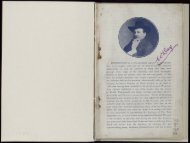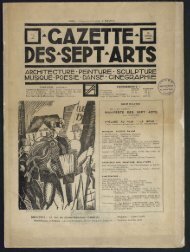Untitled
Untitled
Untitled
You also want an ePaper? Increase the reach of your titles
YUMPU automatically turns print PDFs into web optimized ePapers that Google loves.
22 MODERN MAGIC LANTERNS. HOME-MADE OXYGEN, GAS HOLDERS, ETC. 23<br />
iron, removes. A prepared cake of manganese oxide<br />
and potassium chlorate is introduced, the top put on, the<br />
handle replaced, and the gas lit at the Bunsen burner, which<br />
is enclosed in the hollow part underneath<br />
(only the stopcock is<br />
visible in the figure) ; gas rapidly<br />
comes off until, in a quarter of an<br />
hour or less, the cake is exhausted,<br />
and may be replaced by another.<br />
In case of any excess of pressure<br />
in the vessel, the springs at the<br />
side allow the lid to rise and the<br />
gas to escape. The cakes are<br />
made by mixing four parts of<br />
manganese oxide to one part of<br />
the powdered chlorate, enough<br />
water being added to just moisten<br />
the mass, which is then filled into<br />
a mould. The cakes are allowed<br />
to dry, when the bottom of each<br />
is coated with a thin paste of<br />
manganese oxide and water<br />
to prevent it sticking to the<br />
Fig. 16. OXYGEN RETORT.<br />
retort. The use of the cakes entirely prevents the choking<br />
up of the retort with the decomposed oxygen mixture, the<br />
bye-product coming away in a mass just as the cake was<br />
inserted. We recently saw one of these working in conjunction<br />
with a large gas holder of the type shown in Fig. 14.<br />
It had been in use for many years; making oxygen for<br />
enlarging purposes, without the slightest hitch. Another<br />
form designed by Mr. Chadwick has a weighted lid at the<br />
end, which acts when necessary as a dead-weight safety<br />
valve.<br />
For oxygen making, as we said before, the manganese<br />
oxide should be got from a reliable source. The chlorate is<br />
best bought ready powdered if to be made up into cakes as<br />
above described ; if to be used loose, the crystals should be<br />
employed (it is best not to attempt to powder it oneself), and<br />
the manganese used should be the granulated form. Both<br />
ingredients should be carefully picked over for scraps of<br />
cork, straw, etc. When the cakes are not employed, two<br />
parts by weight of chlorate to one of manganese are those<br />
we used in the days when oxygen was not so readily obtainable.<br />
Some workers, however, prefer three, or even four parts<br />
of chlorate.<br />
Whatever retort is used, a gas stove is the most convenient<br />
way of heating it ; the heat should be left on until<br />
at least four cubic feet of oxygen have come off per pound of<br />
chlorate. This is mentioned because the emission of gas is<br />
often irregular, ceasing almost and then coming off with full<br />
force again.<br />
When the gas is to be received in a bag, it should be<br />
washed by allowing it to bubble up, as shown in Fig. 17,<br />
through a Woolff's bottle containing a fairly strong solution<br />
of caustic soda, which will last for several operations, and<br />
then through an empty flask to remove as much as possible<br />
of the water. This washing is not necessary when a<br />
pneumatic holder is to be employed. When no more gas is<br />
coming off, the stopcock on the bag should be closed and the<br />
tube 'immediately disconnected between the retort and the<br />
first bottle ; if this is not done at once and before the retort<br />
is allowed in any degree to cool, the liquid in the flask will<br />
be sucked back and an explosion<br />
of steam in the retort is<br />
sure to ensue. There should<br />
be no fear of this in any but<br />
the most incompetent hands,<br />
which latter had best leave<br />
limelight alone altogether.<br />
When a gas bag has got hard<br />
through cold, it should be<br />
warmed a little before filling<br />
to soften it. If this is not done<br />
the bag will rapidly perish.<br />
In filling a bag with oxy-<br />
Fig. 17.<br />
APPARATUS FOR MAKING AND<br />
WASHING OXYGEN.<br />
gen the sequence of operations should be as follows<br />
(1) Having connected the retort and flasks as shown,<br />
and having the empty bag with its stopcock open and<br />
tube ready to connect to the last flask, apply heat to<br />
the retort until gas bubbles off freely.

















